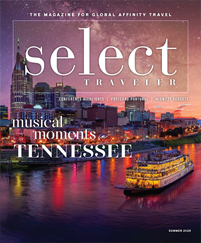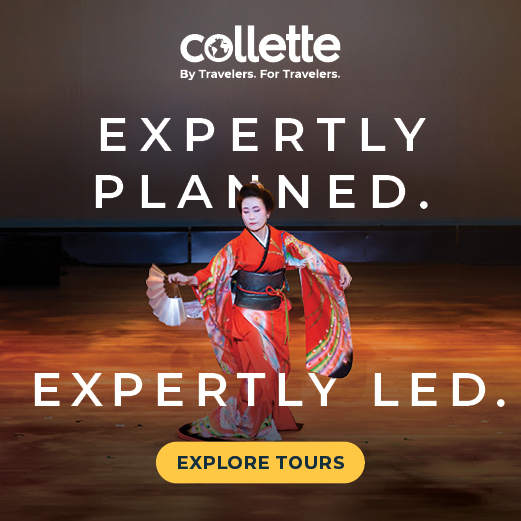Over espressos at a street-side cafe in Bologna, I asked Alexa Dorobantu which better captures the essence of Italy: food or fashion. She paused, then laughed.
“I cannot choose,” she said. “But I will say this: I will give up my pizza every now and then to buy a Gucci belt!”
Dorobantu knew she had inspired this and other questions with her animated references to all things edible or wearable as our tour director on this Collette Spotlight tour of Tuscany. Youthful and expressive, her use of the English language veered between flawless and priceless.
When asked if contemporary culinary trends had taken root in Italy, she answered, “Yes, it’s a thing to be vegan right now. But for me, if you are vegan, you should not even wear shoes!”
Describing a region of Italy where men hold traditional sway over family matters, she created classic irony when she observed, “There, it’s the men who fold the pants in the family.”
“We are very warm people,” she said, as we talked, just paces off Bologna’s boisterous outdoor market. “We embrace. We’re welcoming and open-hearted. In Sicily, you are best friends in five minutes. In Venice, it takes longer, but be patient.”
Sicily and Venice will have to wait. My wife, Kim, and I were spending this week with a Collette group in Tuscany.
Florence
Dorobantu gave us radio headsets to listen to her commentary as we arrived in Florence and warned us that they cost $100 to replace.
“Don’t lose your radio — that’s a pair of shoes,” she said.
Florence remains the cradle for one of civilization’s greatest leaps forward. Steeped in Renaissance art and architecture, it demands to be enjoyed at street level. Historians place the Renaissance between the 14th and 17th centuries, and the near entirety of Florence’s ancient core is a UNESCO World Heritage Site. The Piazza del Duomo; the Accademia Gallery, home to Michelangelo’s David; the Uffizi Gallery, Florence’s Renaissance art repository; and the sculpture-resplendent Piazza del Signorio are within minutes of one another. The city’s iconic Ponte Vecchio bridge, built in 1345, crosses the Arno River just another few steps away.
It was All Saints Day when we arrived, and the local crowds were enormous. Just grabbing a gelato required commitment. Getting into major sites like the Uffizi or the Pitti Palace, built in the 1450s, was impossible, but Collette had arranged entry into the Accademia Gallery, so we walked into what looks like Michelangelo’s workshop. Brawny, half-formed figures emerge from blocks of marble as you walk toward the David, sculpted in 1504. They look unfinished but aren’t.
“Life is a struggle,” our guide said. “We are imprisoned in our bodies. Michelangelo believed this. His unfinished sculptures represent this.”
We stood before his masterpiece, whose steely countenance has defined resolve for centuries. “Don’t tell me you see fear because it does not exist,” said our guide. “We see determination.”
As we stood in the piazza surrounding the Duomo, Dorobantu cautioned those thinking about climbing the steps to its cupola, a Florence landmark.
“Take your time,” she said. “They’re not Hollywood steps — they’re Renaissance steps.”
Kim and I were hungry, so we crossed the crowded Ponte Vecchio, then navigated side streets to find Gustapizza. This pizzeria was so busy that we had to split up to order and find a table. We traded travel stories at a high-top with a young couple from Austria, then spent the afternoon with the crowds enjoying gelato and shopping in the city of Da Vinci and Michelangelo.
That evening, we had a raucous dinner and cooking demonstration at Amici del Colle in Montecatini Terme and began meeting friends we’d enjoy throughout the week. This tour included travelers from Cleveland, a chamber group from Rochester, a travel club out of Houston and a group from a Seattle community center.
Pisa
It may be unorthodox to mention Pisa’s lively downtown before its beloved square, but it’s not unreasonable. After viewing the famously leaning tower, cathedral and baptistry, we spent a couple of hours walking through this college town. Pisa is a coastal city but is also dissected by the Arno River, just minutes away from the tower. Pisa University, established in 1343, creates a youthful vibe in a medieval city.
Some of the best commentary we heard in Pisa was at the expense of Lucca, our next stop. The two towns have shared a heated rivalry for centuries.
“Americans say their country is young — but actually, Italy is young,” our guide said. “We’ve only been a country since 1861. Until then, Pisa was Pisa, Rome was Rome, Florence was Florence, and Lucca, unfortunately, was Lucca.”
He walked us through Pisa’s revered Campo dei Miracoli, a monumental campus featuring white marble architecture, and discussed its Cattedrale, Baptistery and Leaning Tower, built in 1063, 1153 and 1173, respectively. He pointed out the symmetry of the structures and their spatial relationships.
“The Renaissance was more about math than art in its beginnings,” he said. “It began with calculations like those required to construct these magnificent structures. Numerals led the way, not Michelangelo.”
For the record, the tower not only leans, it also bends. It began leaning early on, so subsequent construction negated that by tilting it back toward center.
Lucca
The day before our arrival in Lucca, the city had hosted its version of Comicon, an event that attracts thousands of comic book and movie fans, many dressed in elaborate costumes. White tents spread across the city, and costumed characters shuffled about.
Lucca is pristine, and its massive medieval wall, the Passeggiata delle Mura, accommodates many walkers and bicyclists. Lucca is the birthplace of composer Giacomo Puccini, and music endures.
“Lucca draws major rock stars like the Rolling Stones for concerts,” said Dorobantu. “It’s cooler and breezier than Florence for outdoor events like that.”
“We had 400,000 visitors here in five days,” said our guide, clearly unhappy about the costumed crowds invading her beautiful city: “You see these horrible tents.” Then she started in on Pisa: “So you were in Pisa yesterday. I hope you heard good things about Lucca. I doubt it. St. Michael’s Church was built in the 12th century, and its bell tower stands perfectly straight — like every bell tower in Lucca.”
We loved Lucca. An ancient Roman amphitheater there, Piazza Anfiteatro, dates to the second century and has been retrofitted with cafes and shops. We had lunch nearby and bought several gifts. It would be easy to spend a morning on Lucca’s town wall.
On our way home, someone surveying the medieval landscape asked about ghost tours in Italy. “We have no ghosts in Italy,” Dorobantu said. “That’s a thing in America. A ghost tour here is a knockoff.”
Siena
Siena is known for its mammoth town square, Piazza del Campo, which is punctuated by the magnificent marble Duomo, and for its ancient neighborhood districts. There are 17 districts, each with its own stable, and the no-holds-barred horse races through town during its Palio delle Contrade are legendary.
Siena’s districts feature distinctive names like the Goose, the Forest or the Panther, and residents born to one remain loyal forever. Naturally, the winning district in each summer’s horse race enjoys serious bragging rights.
“Siena has had a problem with water supply for centuries,” said our guide. “So while every district has a fountain, they are only turned on for baptisms. You are baptized into your district and your church. Family reunions take place in our districts during the horse races.”
After a walking tour, uphill and down, through Siena’s stone streets, Dorobantu surprised us with entry into the Forest district’s small church. Like most in Italy, it is filled with original art, but our guide discussed something else.
“For the Palio, the horses are blessed,” she said. “The door opens, and the horse comes to the altar. The priest blesses it with holy water, saying, ‘Go, and come back a winner.’ The jockey is not mentioned — only the horse. We bribe the jockeys to lose. We spend all winter figuring out who bribed the jockeys.”
We asked for a restaurant recommendation and landed at Antica Trattoria L’Aquila. Kim had cheese and spinach ravioli in wild boar sauce, and I had spaghetti with tomatoes, sausage and pecorino. Kim noticed two large newspaper clippings on the wall of an exuberant Palio spectator running wildly alongside thundering horses.
“Is that him?” she asked our waiter, pointing to the owner at the register. Our waiter laughed and called to the proprietor. He came over, and speaking entirely in Italian, explained that his district had won those races and that in the picture, he was celebrating on the track.
Bologna
Unlike most Italian cities, Bologna is a city of porticos — or “loggias” — that overhang sidewalks to repel weather. It is an elegant city and, like Pisa, is a college town. Bologna University, established in 1088, is considered the oldest in Europe. As we learned firsthand, it is home to a mesmerizing street market in the Quadrilatero, its medieval center. This is the place to go for fresh fish, meats and vegetables, as food is taken seriously in Bologna, enough so that our guide offered this advice should we return:
“If you are having a business meal in Bologna, eat first, then talk.”
She took us into Tamburini, a delicatessen where tables were set for us in the back, and we had a delightfully spontaneous lunch of charcuterie selections with wines.
San Gimignano
Close your eyes and imagine a town on a Tuscan hilltop. That’s San Gimignano. Like nearby Volterra, it rises above its surroundings, its medieval towers peering across rolling terrain for miles. Towers were built as a sign of wealth in the Middle Ages, and today, 14 of 72 towers built in the 12th and 13th centuries remain. Like Florence, its town center is a UNESCO World Heritage Site.
Dorobantu extolled the virtues of the local gelato, pointing out that Gelateria Dondoli has twice been named the world’s best. A bright sun welcomed us to San Gimignano, and our group spread out to enjoy its acclaimed collection of artisans shops. Kim and I bought two handcrafted ceramic pieces from the artist himself at Corsini Ceramiche.
On our way to Fattoria Lischeto for lunch, I watched as a valley beneath us began to move. Hundreds of white sheep scuttled in unison across the base of an emerald hillside. After a winding entry on a gravel driveway through classic Tuscan countryside, we were greeted to this small farm by a braying white donkey that sprinted up his pasture to greet us like an old friend.
“Our family bought this land in 1962 and turned it into an organic farm in 1991,” said our host. “We came from Sardinia. We became cheesemakers and are now sending cheese to Europe, the United States and China. Today, we have 20 apartments for guests.”
We enjoyed a wonderful meal there that included insalata forro, fondue, beef carpaccio, stracchino cheese and an antipasto plate. It was our last loud lunch together, and it tasted like an exclamation point.
By trip’s end, I had to agree with Dorobantu. Between world-class food and fashion, Renaissance art and architecture, and maybe newfound friendships, defining the essence of Italy is a lot like defining the genius of Michelangelo: It’s best not to try.
For more information on this itinerary contact Collette at 844-445-5663 or go to www.gocollette.com.









